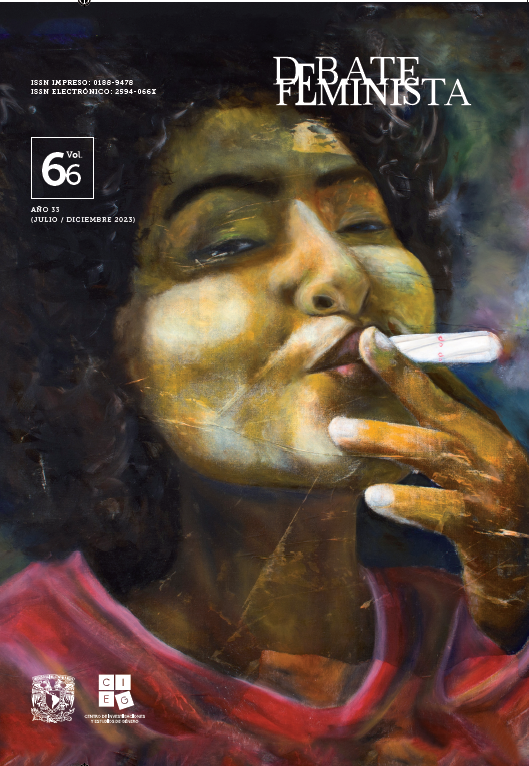Production of gender differences in science: power, identity, and discourse
Main Article Content
Abstract
The purpose of this research is to explore the production of gender differences in the school context, particularly in natural science classes, by analyzing the power relations embedded in discursive and material mechanisms that establish gender norms for the production of differences, asymmetries and discriminatory practices. To achieve the objectives, we designed multiple case studies at three schools in Santiago de Chile, one for boys, another for girls and a mixed one. Research practices were guided by an ethnographic approach that incorporates in-depth interviews with actors from the educational community. The interrelated results produced in the three cases show how the specific discourses of heteronormativity act in the creation of the power relations or strategic relations underpinning what is understood by “gender differences” in the school context.
Article Details
Esta es una publicación bajo la licencia Creative Commons Attribution-Non Commercial-No Derivatives 4.0 International (CC BY-NC- ND 4.0). Para mayor información sobre el uso no comercial de los contenidos que aquí aparecen, favor de consultar http://creativecommons.org/licenses/by-nc-nd/4.0/
References
Britzman, Deborah. 2016. “¿Qué es esa cosa llamada amor?”, en Pedagogías transgresoras, Córdoba, bocavulvaria, pp. 31-65. Disponible en
Brotman, Jennie y Felicia Moore. 2008. “Girls and Science: A Review of Four Themes in the Science Education Literature”, Journal of Research in Science Teaching, vol. 45, núm. 9, pp. 971-1002. https://doi.org/10.1002/tea.20241.
Butler, Judith. 2002. Cuerpos que importan. Sobre los límites materiales y discursivos del “sexo”, Buenos Aires, Paidós.
Canal France 24 Español. 2018, 6 de junio. “Tomas universitarias contra el acoso en Chile” [archivo de video]. YouTube. https://www.youtube.com/watch?v=A5v2_UJR89s.
CEDAW (Convención sobre la eliminación de todas las formas de discriminación contra las mujeres). 1979. “Convención sobre la eliminación de todas las formas de discriminación contra la mujer”, Naciones Unidas, Derechos Humanos. Disponible en
Ciccia, Lucía. 2018. “La dicotomía de los sexos puesta en jaque desde una perspectiva cerebral” (en línea). Descentrada, vol. 2, núm. 2. Disponible en
Cousins, Andrew y Martin Mills. 2014. “Gender and High School Chemistry: Student Perceptions on Achievement in a Selective Setting”, Cambridge Journal of Education, Vol. 45, núm. 2, pp. 187-204. https://doi.org/10.1080/0305764X.2014.934202.
De Fina, Débora y Francisca Figueroa. 2019. “Nuevos ‘campos de acción política’ feminista: una mirada a las recientes movilizaciones en Chile”, Revista Punto Género, núm. 11. Disponible en
Derecho UC despierta. (2018, 14 de mayo). Derecho UC despierta: carta de alumnas recopila frases terribles que se escuchan en las salas de la Facultad. El Dinamo. Disponible en
Dunne, Máiread, Sara Humphreys y Fiona Leach. 2006. “Gender Violence in Schools in the Developing World”, Gender and Education, vol. 18, núm. 1, pp. 75-98. https://doi.org/10.1080/09540250500195143.
Esteban, Mari Luz. 2004. Antropología del cuerpo. Género, itinerarios corporalidad, identidad y cambio, Barcelona, Ediciones Bellaterra.
flores, valeria. 2015. “Pedagogías, afectos, infancias y heteronormatividad. Reflexiones sobre el daño”, Ponencia presentada en el XX Congreso Pedagógico Poéticas de las Pedagogías del Sur. Educación, Emancipación e Igualdad, Unión de Trabajadorxs de la Educación, Ciudad Autónoma de Buenos Aires, 2015.
Foucault, Michel. 2009. Vigilar y castigar. Nacimiento de la prisión, Ciudad de México, Siglo XXI.
Foucault, Michel. 2011. Historia de la sexualidad. La voluntad del saber, Ciudad de México, Siglo XXI.
Gobierno de Chile, Ministerio de Relaciones Exteriores. 1971. Decreto 764 de 1971. Aprueba la Convención relativa a la lucha contra las discriminaciones en la esfera de la enseñanza, 4 de noviembre de 1971.
Gobierno de Chile, Ministerio de Relaciones Exteriores. 1980. Decreto 789 de 1980. Promulga la Convención sobre la eliminación de todas las formas de discriminación contra la Mujer, adoptada por la Asamblea General de las Naciones Unidas, 17 de julio de 1980.
Haraway, Donna. 1995. Ciencia, cyborgs y mujeres. La reinvención de la naturaleza, Madrid, Cátedra.
Hsiao-Ching, She. 2000. “The Interplay of a Biology Teacher’s Beliefs, Teaching Practices and Gender Based Student-Teacher Classroom Interaction”, Educational Research, vol. 42, núm. 1, pp. 100-111. https://doi.org/10.1080/001318800363953.
Jones, Gail, Ann Howe y Melissa Rua. 2000. “Gender Differences in Students’ Experiences, Interests, and Attitudes Toward Science and Scientists”, Science Education, vol. 84, núm. 2, pp. 180-192.
Kahveci, Ajda, Sherry Southerland y Penny Gilmer. 2007. “From Marginality to Legitimate Peripherality: Understanding the Essential Functions of a Women’s Program”, Science Education, vol. 92, núm. 1, pp. 33-64. https://doi.org/10.1002/sce.20234.
King, Natalie y Rose Pringle. 2018. “Black Girls Speak STEM: Counterstories of Informal and Formal Learning Experiences”, Journal of Research in Science Teaching, vol. 56, núm. 5, pp. 539- 569. https://doi.org/10.1002/tea.21513.
Koul, Ravinder, Thanita Lerdpornkulrat y Soontornpathai Chantara. 2010. “Relationship Between Career Aspirations and Measures of Motivation Toward Biology and Physics, and the Influence of Gender”, Science Education Technology, vol. 20, núm. 6, pp. 761-770. https://doi.org/10.1007/s10956-010-9269-9.
Lauretis, Teresa de. 1989. Technologies of Gender. Essays on Theory, Film and Fiction, Londres, Macmillan Press.
Le Mat, Marielle. 2016. “‘Sexual Violence Is Not Good for Our Country’s Development’. Students’ Interpretations of Sexual Violence in a Secondary School in Addis Ababa, Ethiopia”, Gender and Education, vol. 28, núm. 4, pp. 562-580. https://doi.org/10.1080/09540253.2015.1134768.
Mattern, Nancy y Candace Schau. 2002. “Gender Differences in Science Attitude-Achievement Relationships Over Time among White Middle-School Students”, Journal of Research in Science Teaching, vol. 39, núm. 4, pp. 324-340. https://doi.org/10.1002/tea.10024.
Matus, Claudia. 2019. “Queering Habits and Entanglements of the Normal and Deviant Subjectivities in Ethnographies”, en Claudia Matus (comp.), Ethnography and Education Policy. A Critical Analysis of Normalcy and Difference in Schools, Nueva York, Springer, pp. 61-89.
Meyer, Elizabeth. 2008. “Gendered Harassment in Secondary Schools: Understanding Teachers’ (Non) Interventions”, Gender and Education, vol. 20, núm. 6, pp. 555-570. https://doi.org/10.1080/09540250802213115.
Ministerio de Educación (MINEDUC). 2019. “Comisión por una educación con equidad de género. Propuestas de acción”, Gobierno de Chile. Disponible en
Naciones Unidas. s.f. Convención relativa a las luchas contra las discriminaciones en la esfera de la enseñanza (CADE). Disponible en
Patrick, Helen, Panayota Mantzicopoulos y Ala Samarapungavan. 2008. “Motivation for Learning Science in Kindergarten: Is There a Gender Gap and Does Integrated Inquiry and Literacy Instruction Make a Difference”, Journal of Research in Science Teaching, vol. 46, núm. 2, pp. 166-191. https://doi.org/10.1002/tea.20276.
Riegle-Crumb, Catherine, Chelsea Moore y Aida Ramos. 2010. “Who Wants to Have a Career in Science or Math? Exploring Adolescents’ Future Aspirations by Gender and Race/Ethnicity”, Science Education, vol. 95, núm. 3, pp. 458-476. https://doi.org/10.1002/sce.20431.
Sadler, Philip, Gerhard Sonnert, Zahra Hazari y Robert Tai. 2012. “Stability and Volatility of STEM Career Interest in High School: A Gender Study”, Science Education, vol. 96, núm. 3, pp. 411-427. https://doi.org/10.1002/sce.21007.
Scantlebury, Kathryn y Dale Baker. 2007. “Gender Issues in Science Education Research: Remembering Where the Difference Lies”, en Norman Lederman y Sandra Abell (comps.), Handbook of Research on Science Education. Nueva York, Routledge, pp. 257-285.
Serrato, Abraham y Raúl Balbuena. 2015. “Calladitos y en la oscuridad. Heteronormatividad y closet, los recursos de la biopolítica”, Culturales, vol. 3, núm. 2, pp. 151-180.
Sinnes, Astrid. 2006. “Three Approaches to Gender Equity in Science Education”, Nordic Studies in Science Education, vol. 2, núm. 1. https://doi.org/10.5617/nordina.451.
St. Pierre, Elizabeth. 2000. “Poststructural Feminism in Education: An Overview. Qualitative Studies in Education”, International Journal of Qualitative Studies in Education, vol. 13, núm. 5, pp. 477-515. https://doi.org/10.1080/09518390050156422.
UNESCO (Organización de Naciones Unidas para la Educación, la Ciencia y la Cultura). 2018. “Cumplir nuestros compromisos de igualdad de género en la educación”, resumen sobre género del Informe de Seguimiento de la Educación en el Mundo. Disponible en
Yılmaz-Tüzün, Özgul y Mustafa Sami. 2013. “Exploration of Preservice Science Teachers’ Epistemological Beliefs, World Views, and Self-Efficacy Considering Gender and Achievement.” Elementary Education Online, vol. 12, núm. 3. Disponible en
Zapata, Mara y Alejandro Gallard. 2007. “Female Science Teacher Beliefs and Attitudes: Implication in Relation to Gender and Pedagogical Practice”, Cultural Studies of Science Education, vol. 2, núm. 4, pp. 923-985. https://doi.org/10.1007/s11422-007-9069-6.



